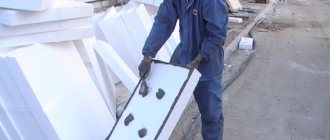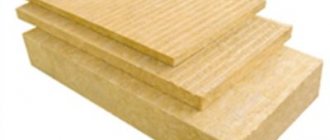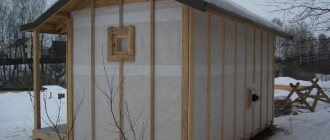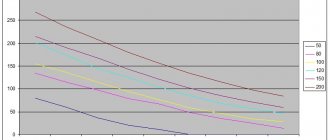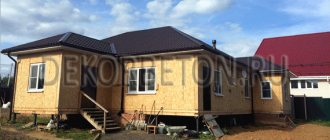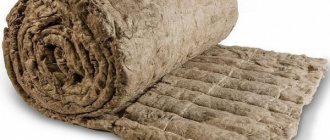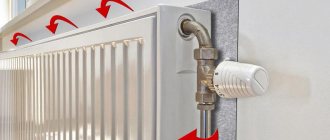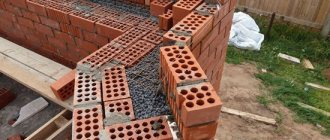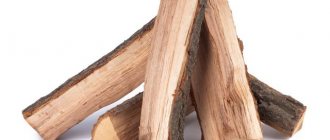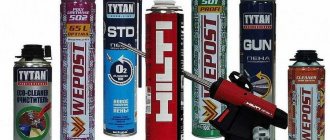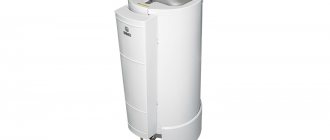Warning
: Use of undefined constant callback_thumbing_img - assumed ‘callback_thumbing_img’ (this will throw an Error in a future version of PHP) in
/srv/sites/stroim.guru/wp-content/themes/stroim.guru/includes/kama_thumbnail.php
on line
337
In the process of building houses, thermal insulation works are carried out. For this, the formation of cold bridges is excluded. The desired result is achieved by reducing the number of seams in the heat-insulating layer and sealing adjacent structures.
For this, it is recommended to use seamless insulation, one of which is foam for wall insulation and other structural elements.
Thermal insulation of the house with foam
Thermal insulation work is one of the most important stages of construction. This applies to technical structures and residential buildings. High-quality insulation can significantly reduce energy costs and extend the life of walls and finishing materials.
Thermal insulation with polyurethane foam (PPU) came to the construction market recently, but quickly gained popularity among professionals and customers. This technology can significantly reduce the time spent on work. Polyurethane foam can be used as a heater on any surface, since it has high adhesion rates and has practically no restrictions.
Wall insulation can be done in three ways:
The method is selected based on the individual characteristics of the premises and the calculation of the cost of work. But each of these methods has its own characteristic nuances that must be taken into account. Spraying and insulation with plates is carried out both outside and inside the house. And the filling is carried out into the air space between the parts of the partition, which is specially left during the construction phase.
1. Spraying technology.
Due to its high adhesion, polyurethane foam instantly adheres to the base and creates a uniform layer, in which there are no cold spots inherent in most types of thermal insulation. Foam insulation by spraying is carried out using special equipment. It can be professional, and is used repeatedly, as well as one-time, which is quite suitable for work on your own.
If it is necessary to insulate a small room, for example, a loggia in an apartment, foam from ordinary cylinders is often used. It differs slightly in consistency, but contains the same polyurethane in the base. The application technology is similar to spraying with professional devices, which are used by specialists, but occurs much more slowly due to the low pressure in the cylinder. Polyurethane foam has a higher cost, but it is compensated by the fact that you do not need to buy equipment.
- As a result of expansion, it completely fills the area to be insulated.
- There is no need to level the walls before application.
- High speed of work performed.
- Relatively high cost.
2. Technology of filling.
If the house is under construction and polyurethane foam is selected, a special wall construction is required, which provides for an internal empty space, where the foam is filled. But even if the house is already fully built, thermal insulation is possible through special technological holes, which are drilled in several places, and foam is pumped through them. The device delivers insulation through hoses inserted into the wall. After the material has completely solidified, dense thermal insulation is obtained, excluding air chambers.
- Has the highest efficiency and energy saving rates.
- The internal space is fully preserved, and additional external finishing is not required.
- Do-it-yourself polyurethane foam insulation by filling is impossible without specialized equipment.
- The injection through the holes does not exclude the formation of air bubbles inside.
- The pressure that the foam creates during expansion can damage the walls if the house is made of poor quality materials.
The foam is presented not only in a liquid state, but also in the form of finished slabs. Insulation is performed by gluing the segments to the surface and fixing them using dowels with a wide head. Unlike spraying, this process does not require special equipment and can be done by hand.
To prevent the insulation from accumulating condensate, before installation, the surface must be treated with impregnations that prevent the appearance of mold and mildew. This should be done not depending on which side the house is insulated from. At the final stage, polyurethane foam is filled into the seams from a cylinder. Thus, the thermal insulation becomes monolithic.
- Lowest cost among other methods.
- Ease of installation.
- Thermal insulation of PU foam plates is not so effective in terms of energy saving.
- The house needs decorative finishing.
- For installation, you must first level the surface, otherwise the insulation will lie unevenly.
- Foam in slabs has a lower degree of durability.
Penoizol has a similar structure to polyurethane foam, but differs in technical characteristics. According to the standards, in rooms with increased requirements for fire and environmental safety, such as:
- Public places.
- Kindergartens and schools.
- Medical institutions.
Insulation with polyurethane foam is prohibited due to the flammability and toxicity of products emitted as a result of combustion. This applies to both the slab version and the liquid one. Fire safety rules allow the use of polyurethane only in private construction or in the construction of non-residential premises.
In turn, penoizol complies with all standards and has no restrictions on use. It is made on the basis of a complex chemical compound - urea-formaldehyde. It is a porous white material with a lot of air bubbles. The main advantage of spraying foam insulation over polyurethane is that it does not support combustion at all, and at high temperatures decomposes into carbon dioxide, nitrogen and water. The absence of toxic emissions allows this insulation to be used in any premises, regardless of their intended purpose.
Warming process
[Click on photo to enlarge]
Polyurethane foam is a one-component polyurethane polymer with gas, which displaces it from the cylinder. Polyurethane foam is used as insulation in many building structures.
After leaving the container, the foam expands and fills the space provided for it for foaming. Price polymerization occurs due to contact with moisture in the ambient air. The foam has an open cell structure with no more than 50% closed pores. As a result of the reaction of the polymer with moisture, carbon dioxide is released, which is filled with half of the foam cells, and the other half is filled with air. The thermal conductivity coefficient of the polyurethane foam, as a rule, is not more than 0.033-0.04 W / m * C.
Installation foams are usually designed to seal joints when installing window and door blocks and to fill small voids.
Traditionally, the installation of a window implies the following: fixing the block in the opening, foaming the seam with polyurethane foam, making the slopes of window sills and other structural elements.It often happens that excess foam is cut off for further work, for example, plastering slopes, and, accordingly, the number of open cells increases significantly.
If the seam is not made according to GOST, without the necessary hydro and vapor barrier, then in winter humidity and steam from the room will gradually replace the air in the foam cells, the vapor will diffuse outward gradually and significantly reducing the thermal insulation properties of the foam. In summer, the process of moisture saturation will continue on the other side, from the side of rain, the process of foam destruction under the influence of UV rays may increase. As a result, the seam will begin to freeze and become a cold bridge.
For a more complete preservation of the thermal insulation properties of the mounting foam, as a heater when installing window and door blocks, technological standards have been developed that regulate the assembly seam using mounting foam. As a heat-insulating layer, polyurethane foam is now used everywhere, provided that the surface layer remains intact. Sometimes it is permissible to cut off the surplus, but only from the inside and only with a device on this side of the continuous vapor barrier circuit.
The foam is applicable for insulating the walls of houses inside and outside. There are types of material that have their own application characteristics, certain drying times. The main criterion for insulation is the absence of cold bridges.
Foam for wall insulation is the best option to create coziness, a comfortable stay and dryness in the house. Since it is sealed to the surface, there will be no cracks for cold air to enter.
It is widely used for wall insulation outside and inside. They are applied using a special apparatus or with a pistol. The material fits well on vertical, horizontal and inclined surfaces.
Features of wall insulation:
- The walls get thicker, which leads to more resistance from the environment.
- The material is able to withstand temperatures up to 80.
- Water vapor permeability.
- Resistant to various types of damage. It will not crumble or deform from the blow.
- The material does not burn.
The following objects are insulated:
- window openings;
- walls from the street;
- foundation;
- balcony, attic;
- pipelines;
- attic rooms.
There are no seams or joints after application. The foam hardens from 1 to 3 days, depending on the number of layers applied.
Indoor insulation is carried out as a last resort. Only when it is not possible to carry out work, if the apartment is on the upper floors. This is indicated in SNiP 23-101-2004.
Carrying out wall insulation inside the room, you should take care of waterproofing, because the dew point is shifting. The walls will be wet, which will lead to the appearance of fungus and the destruction of the supporting structure.
Insulating the outside is the right solution. The dew point violation is not the main factor. The walls will be warm and dry.
Benefits from outside insulation:
- High energy saving data.
- Inside, the footage remains the same.
- No condensation.
- Sound insulation performance improves.
Disadvantage: foam insulation requires the use of equipment.
Even with the inflated cost of the material, the equipment used, the work of the craftsmen, this pays off in savings (payment for heat), silence, and comfort.
There are 3 types of foam:
- Mounting room.
- Polyurethane, consisting of 2 substances.
- Liquid foam - penoizol.
Other types, on the packaging of which the scope of application is clearly indicated.
This is a one-piece heat insulator. Warming can be done independently.
Types of polyurethane foam:
- facade - having a large temperature range. It can withstand minus and plus temperatures;
- usual - for sealing cracks, sealing seams;
- with extra strength;
- glue foam.
A construction gun is used to apply the material.
Penoizol is similar to polyurethane foam, but it has a different composition. It has a low level of density, does not allow cold, sounds, moisture to pass through. It is most often used to insulate houses.
Applying the material requires equipment, dry warm weather. After the completed work, it takes 5 days for complete drying, only the top is used for finishing work.
Polyurethane foam consists of 2 substances. It is the best material for building thermal insulation. For installation, balloon equipment is used. The material on the surface hardens within 10-20 minutes. The structure is closed cells, which have a minimum indicator of thermal conductivity, sound insulation, moisture penetration.
One layer of applied material is 6 cm thick. Sometimes, after complete hardening, a 2 layer is applied for strength.
The difference is the very good adhesion to various materials.
Basically, they independently carry out internal work on thermal insulation. This requires:
- Wooden battens or metal profiles as guides for the battens.
- Foam in spray cans and a construction gun.
- Construction knife.
First, the surface in the house is cleaned of dust, tsvili, cobwebs. After that, the profiles are fixed with a pitch of 50 cm vertically along the wall, with horizontal bridges of 50 cm.
- Safety measures: glasses, protective clothing, gloves.
- Apply some automotive lubricant to a construction gun for best performance.
- Insert the can into the gun.
- Apply foam to the surface.
We offer you to familiarize yourself with: Do-it-yourself paving slabs
Clean the gun after use. If liquid remains in the bottle, close it tightly.
Wait for complete drying - from 1 to 3 days. After finishing finishing.
Before mounting the lathing, it is necessary to prepare the surface.
Cleans from dust and cobwebs.
If the installation work is carried out on the street, then they are cleaned of old whitewash, swollen plaster, pieces of cement, and other protruding objects.
After cleaning, the guides (wooden slats or metal profiles) are fixed in increments of 50 cm. For strength, horizontal bridges are made every 50 cm. Hardware is used depending on the surface material (anchor, dowel-nails).
All work on laying electrical cables and other communications is done before the start of insulation. Electric wires are laid in a corrugation.
First, all cracks, joints, cracks must be filled with the material. This will get rid of voids where a cold bridge can arise. As well as the voids that have arisen at the junction of the sheathing and the surface.
After that, spraying is done with even sweeping movements from side to side. The surface is covered from top to bottom.
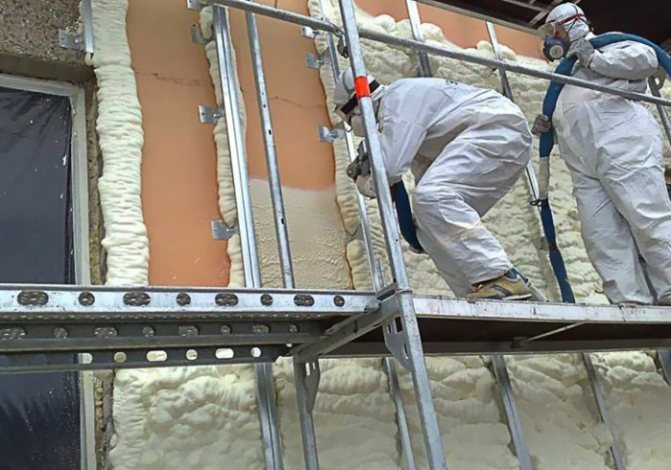
When carrying out work, make sure that the crate remains visible. The finish coating (drywall, chipboard, other materials) will subsequently be fixed on it.
Foaming of the material takes place inside the equipment. After application, it will harden in 15-20 minutes. Complete drying occurs in a day or three.
Experts recommend starting finishing in 5 days.
Alignment
After 5 days, you need to level the surface before finishing. To do this, cut off the excess of frozen foam with a construction knife. They do it on a level with a crate. The surface should be flat, without depressions and bumps. If it is difficult to work with a knife, take a hacksaw with fine teeth.
After that, the finish is fixed on the prepared surface.
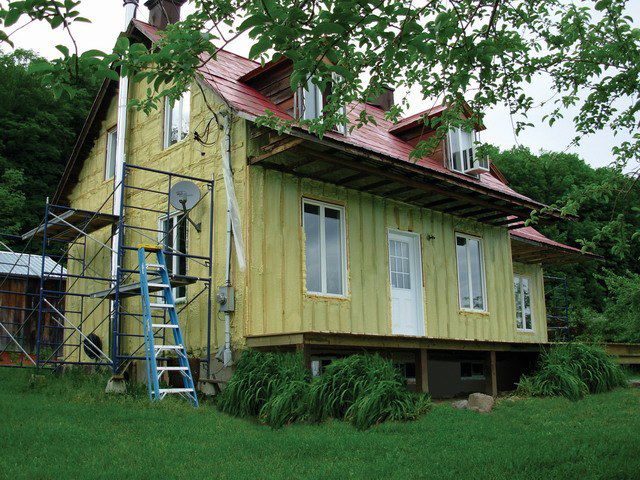

The surface of their foam is not covered with various types of plaster, putty, wallpaper. For cladding used:
- drywall (ordinary, moisture resistant);
- plastic, glass wood panels;
- lining;
- Chipboard, fiberboard, OSB.
The material is fixed with hardware on a previously created crate. No waterproofing layer is required.
The thermal insulation material has no limited service life. After installation, the foam is destroyed by exposure to:
- direct sunlight;
- exposure to ultraviolet radiation;
- carrying out silicification.
Therefore, the heat-insulating layer is covered from above with a finishing material, which serves as a protective layer.
The life of the foam is unlimited under the cladding.
Why do you need to insulate the house? Most likely, this question will cause bewilderment among many ordinary people.
The residential building must be insulated. If you make the thermal insulation of a residential building reliably, then you will be able to create a stable internal microclimate at any time of the year. Thus, the temperature difference and the vagaries of nature will not depend on how comfortable the homeowner and all members of his family will live. Also, by insulating the house, you will ensure reliability of all elements of the structure and increase their durability resource.
Before starting the construction of a private house, it is worth considering in the best way the issue of insulating not only the walls and ceiling, but also the entire structure as a whole. These activities can be performed not only at the construction stage, but also during the operation of the building (it is better to do this in the warm season).
If a residential building has unsatisfactory thermal insulation performance, then this will negatively affect not only the people living in the house, but also the building itself.
All members of your family will be prone to frequent colds. Living in cold rooms will not be comfortable. The walls of the house will be susceptible to freezing, and then the appearance of mold and mildew on them.
If all structural components of the building have increased thermal conductivity, this will cause self-destruction of building materials.
From the above, one conclusion suggests itself: a residential building needs to be insulated. And how this can be done must be decided by each homeowner individually.
In construction work, insulation, as a rule, is carried out with polyurethane foam. It is a polyurethane polymer that is placed in metal cylinders under high pressure during production. The mixture from the cartridge is displaced by gas, expands and, when interacting with air, increases in volume up to 20 times, acquiring a cellular structure.
Foam insulation is a foamed plastic that has high strength and ductility. The density and stiffness of the material depends on the components that make up it.
The main difference between foam and other heat-insulating materials is that it acquires its functional properties only after installation. During its application to the surface, a chemical reaction is observed, as a result of which the mixture hardens and provides excellent adhesion.
Another feature of the material is that it does not leave gaps and seams, which increases its waterproofing characteristics.
The benefits of foam also include:
- environmental friendliness;
- high thermal stability;
- durability;
- resistance to temperature extremes;
- protection of buildings from the appearance of fungus;
- anti-corrosion properties;
- ease of use.
Outside
Penoizol
Liquid insulation usually means foam, which is used to insulate premises. One of its varieties is called penoizol. In structure, this material resembles foam, but in fact it is a urea polymer. Penoizol can be supplied not only in the form of a foam mass, but also in the form of plates. Also, granules are made from it for filling with the main material.
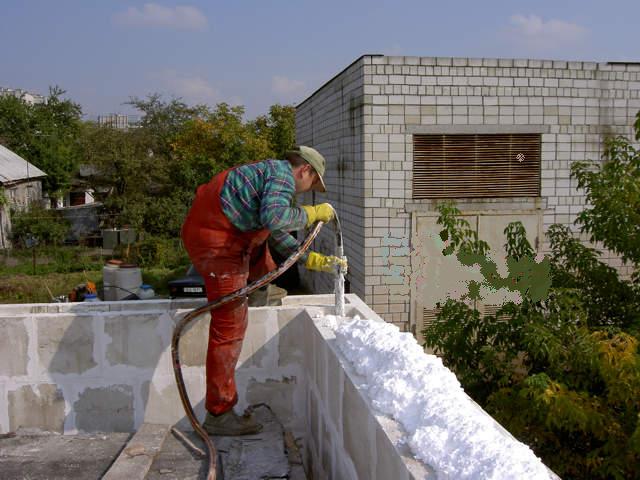

Penoizol is best suited for thermal insulation of frame buildings. It is designed to fill air gaps between:
- inner and outer walls;
- plastic panels and a wall;
- plasterboard and wall;
- wood flooring and its base.
Also, the material is suitable for insulating tanks and heating mains. In terms of operational properties, the foam is superior to mineral wool and expanded polystyrene. The advantages of penoizol are:
- high speed of work execution;
- undemanding to the conditions of temperature and humidity conditions;
- long service life;
- weak flammability;
- elasticity and resistance to deformation.
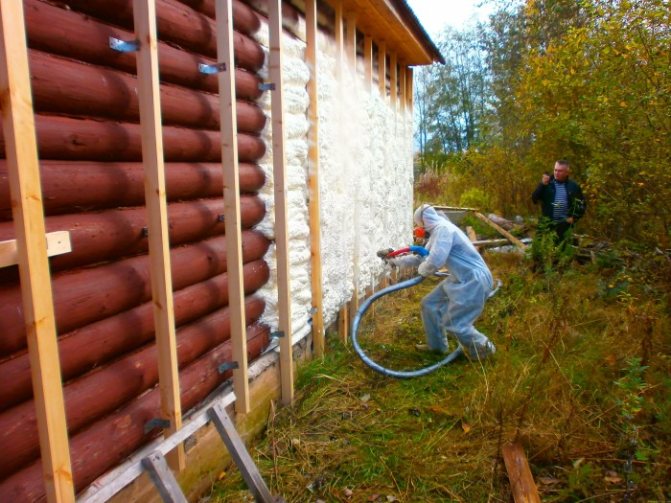

When hardened, the material does not form butt seams, which means it is resistant to tensile loads. In addition, it does not create a favorable environment for the development of fungi and mold, it is not damaged by rodents.
Penoizol has soundproofing properties, and can significantly reduce the level of noise in the living space. In addition, the manufacturer assures that the material is environmentally friendly.
Polyurethane foam
Externally, polyurethane foam resembles ordinary polyurethane foam, but it has a closed fine-mesh structure. The material is applied in a layer from 4 to 8 cm, good adhesion to any materials is ensured. Polyurethane foam has low water absorption, so no additional waterproofing is required. Other benefits include:
- light weight;
- elasticity, the ability to fill voids of any shape;
- low vapor permeability;
- resistance to biological factors, including fungus and mold.
Polyurethane foam
When insulating premises, foam is often used, intended for installation work. There are many varieties of this material, including those that are specially designed for the purpose of warming rooms. Often, foam is used to fix boards of solid thermal insulation materials or to fill the joints between them.
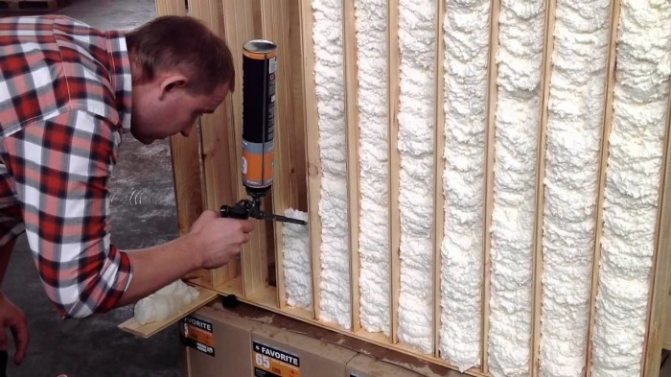

Foam grades with increased adhesion have been developed for use with insulation sheets. In terms of functionality, they resemble glue: foam is applied to the surface of the thermal insulation material and pressed against the wall. Polymerization of the composition takes place within 5-10 minutes, and the board is firmly fixed.
Application features
The application technology has much in common with the use of conventional dyes. Differences, if any, are insignificant. This is how almost any heat-insulating paint is used:
- When the first layer is applied, you need to wait a while until it dries. Only after that do they move on to the next part of the work. This action must be repeated a total of five or six times. The more layers are used, the more likely it is that there will be no problems using the material. This feature is associated with the structure of thermal paints. Temperature doesn't matter.
- After all layers of thermal insulation have been applied and also completely dry, a special film forms on the surface of the base. Its thermal conductivity is much lower than that of standard thermal insulation materials.
- The film on metal surfaces is itself very thin. Therefore, one or two layers are not enough for full effectiveness. The optimal number of layers is 5 or 6. In some cases, this parameter increases, up to ten units.
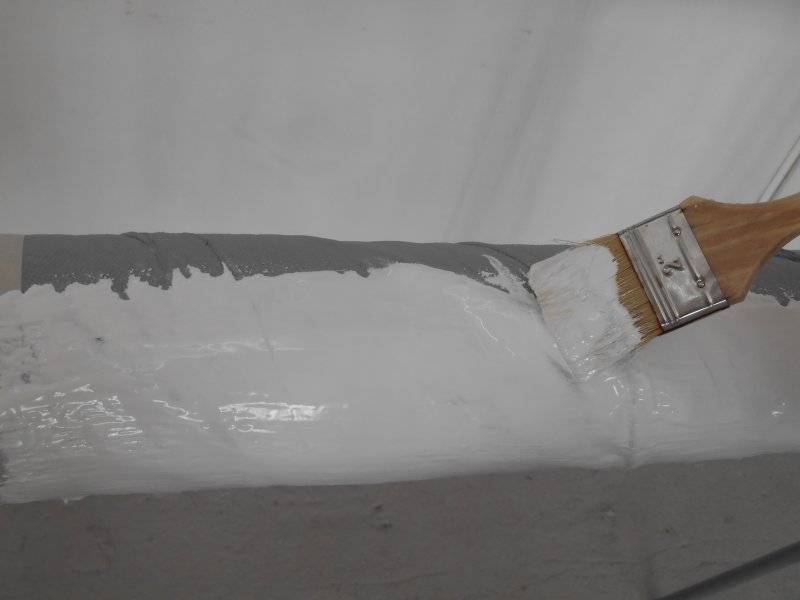

Heat insulating paint
Insulating foam is not the only product for arranging thermal insulation that has a liquid consistency. Liquid ceramic paint is used along with it. Compared to foam, this paint has less pronounced thermal insulation properties. At the same time, the latter has the best waterproofing properties.
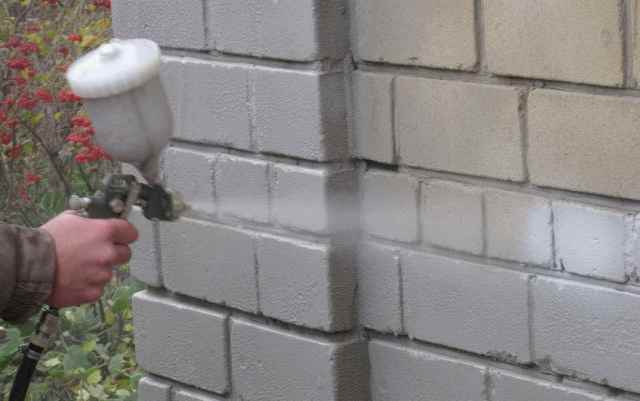

It is recommended to apply paint only at the junction of structural elements of a residential building, for example, between the roof and walls. Some people use this material to insulate rooms from the inside, but this is a big mistake. On the one hand, at least 10 paint coats are required to achieve the desired thermal insulation effect.On the other hand, the thermal insulation layer is never placed on the inside of the walls, as this will lead to the formation of condensation in the building due to an incorrectly calculated dew point.
Paint application
- first you need to decide on the required layer - for this, consult the technical specialists of the company that sells you products. They will help you correctly calculate the required thickness of the insulating layer. This will help not only to preserve the warmth of your home, but also not to waste money on extra millimeters of paint and time to complete the work;
- Stir the paint thoroughly before use. Do not add additional solvents or other mixtures;
- apply paint in layers with a roller, brush or spray. Be sure to let it dry completely - the break between layers should be 24 hours;
- Treat seams, cracks and bends more carefully. Make sure that the insulation is secure in these places. Do not allow the formation of so-called "cold bridges" - otherwise the effect will decrease significantly.
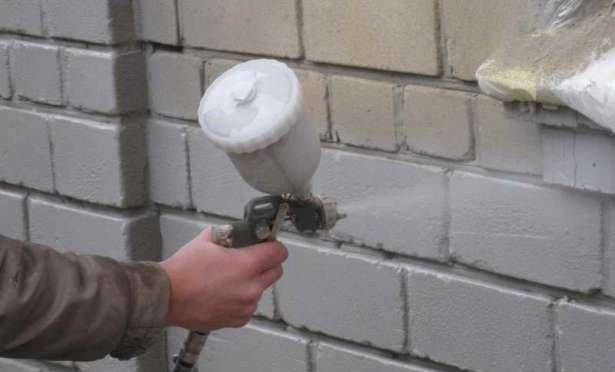

Spray application
Application procedure
The sequence of work depends on which liquid insulation is chosen.
If you decide to use penoizol or polyurethane foam, you need to purchase a disposable or reusable kit for spraying or pouring the mass.
Spraying involves working with open surfaces. The essence of this technology lies in the fact that the foam is sprayed on the wall in an even layer 5-10 cm thick. Before that, the wall is cleaned, and the remnants of wallpaper or paint are removed. With a step of up to 50 cm, guides are attached using self-tapping screws - wooden slats or aluminum profiles.
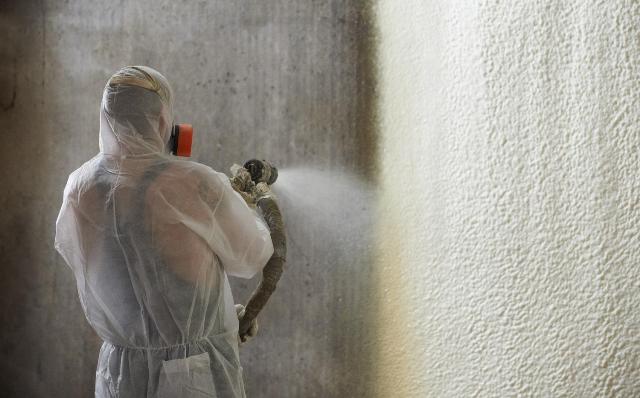

Usually, the guides are located vertically, strictly at right angles to the ceiling and floor, but sometimes horizontal strips are also installed. The space between them is filled with foam, while the guides themselves should protrude above the foam. They are needed in order to mount sheets of drywall on top of them when the insulation is dry.
Fill method
The fill method is more difficult to implement. It consists in filling voids with foam, which cannot be processed by spraying due to difficult access. During pouring, liquid insulation is fed into the cavity, where it is evenly distributed due to its elasticity.
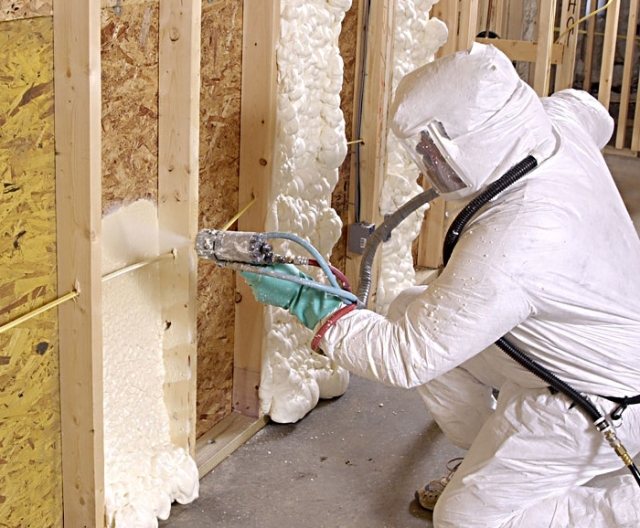

The pouring technology allows you to get rid of voids in the already installed main walls, or after installing the plasterboard coating. In this case, one condition must be fulfilled: there must be access to the cavity at least in the form of a small hole, where the nozzle of the unit for pouring the mass can fit. Sometimes the foam is poured into the mold immediately during production. This is how thermal insulation blocks are obtained, which can later be mounted inside the walls instead of spraying.
Corrosion protection
If thermal insulation of a metal pipeline is planned, then first it must be painted or protected from corrosion in some other way. Manufacturers of penoizol and polyurethane foam never warn about this, but without proper protection, the pipe will rot and crumble. Then you will have to completely remove the insulation in order to gain access to it for the purpose of repair.
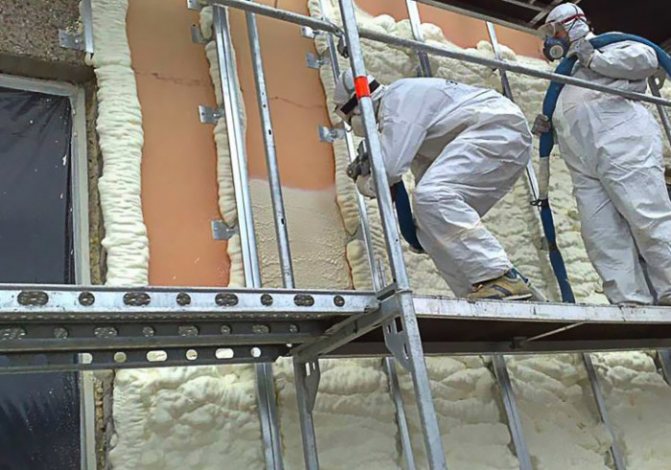

Foam for insulation is fed into a gun for pouring or spraying through hoses from a container with raw materials. In the case of polyurethane foam, these are two tanks, one containing the polyisocyanate and the other containing the polyol. It is important that there is no air in containers and hoses, as it will interfere with the reaction of substances.
Features of foam for insulation
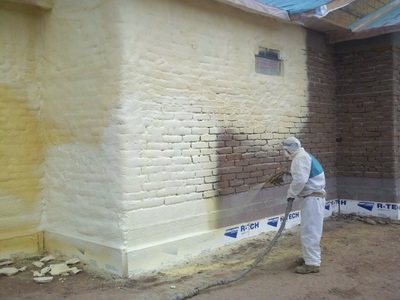

Foam is a gaseous substance, which explains its high thermal insulation properties. It is presented on the market in a wide range.
The difference is that the foam is in a liquid or semi-liquid state. It consists of one or two components.
The material is applied directly to the insulated structure. On contact with air, a gas-filled substance is formed. It continues to expand for some time. At the final stage, the substance is polymerized and solidified.
Despite all the advantages, the material has some disadvantages. Among the main ones are:
- Wall insulation with polyurethane foam involves the use of special equipment. Therefore, it is not always possible to carry out thermal insulation.
- Insulation is somewhat more expensive than other heat-insulating materials, which means that insulation will cost a round sum.
- The substance expands rapidly during application, making it difficult to control the process.
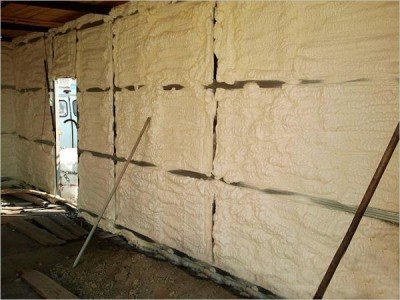

When using foam, it should be borne in mind that the components are toxic. Therefore works do it yourself carried out using protective equipment for the respiratory system, eyes and skin. After polymerization, the substance becomes completely safe.
In addition, it is taken into account that the insulation does not tolerate contact with ultraviolet rays well and should not be left in the open sun for a long time.
Experts recommend finishing the insulated structure immediately after applying the substance. This can be done after a few days, when the composition has completely hardened.
Popular manufacturing companies
Today in Russia there are a large number of manufacturers of foam insulation, polyurethane foam, polyurethane foam and other liquid mixtures that are used to insulate premises. Among the domestic manufacturers, the following are the most famous:
When it comes to buying a disposable construction tool, it doesn't matter what brand it is released under. Along with the Russian ones, Chinese kits are also very popular. At the same time, the choice of the material itself must be taken with responsibility. To avoid premature wear of structures, it is advisable to purchase raw materials of domestic or European production.
How to use foam for insulation
When using foam in cylinders for insulation they adhere to some rules. First of all, you should seriously think about safety. This requires:
- Purchase a special suit in which the work is carried out. This is especially true for carrying out thermal insulation in large volumes when special equipment is used. If we are talking about insulating a small section of the structure, then you can get by with old clothes.
- In the process of spraying, use protective goggles, gloves and respirators. This will protect the respiratory system, skin and eyes from toxic substances that are part of the insulation.
- In advance, you need to purchase a special solvent that removes even the hardened composition.
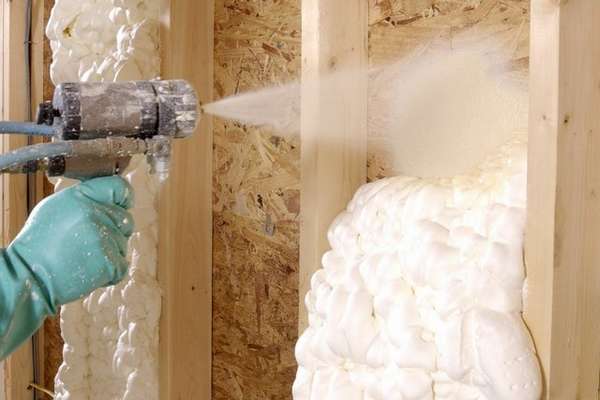

Important! Do not neglect safety precautions, as your health depends on it.
Sprayed insulation is used according to the manufacturer's recommendations. Often, instructions for the use of the composition are applied to the container or packaging.
Features of facade insulation with polyurethane foam
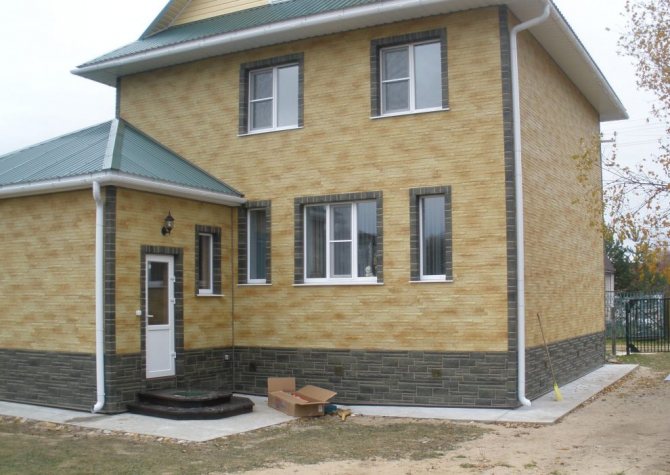

Creating comfortable conditions for living in a house or apartment is the primary task of every zealous owner. Modern technologies make it possible to inexpensively organize an optimal indoor climate and save energy resources at any time of the year. Insulation of facades with polyurethane foam contributes to the extension of the life of the building's structural elements.
Types of polyurethane foam and its properties
Thermal insulation facade is a fast and reliable way to insulate a house. Due to its technical characteristics and method of application, smooth or textured facades of any geometry can be processed.Polyurethane foam (PPU) consists of polymer compounds that are foamed with an inert gas, which provides more than 85-90% of the air pockets.
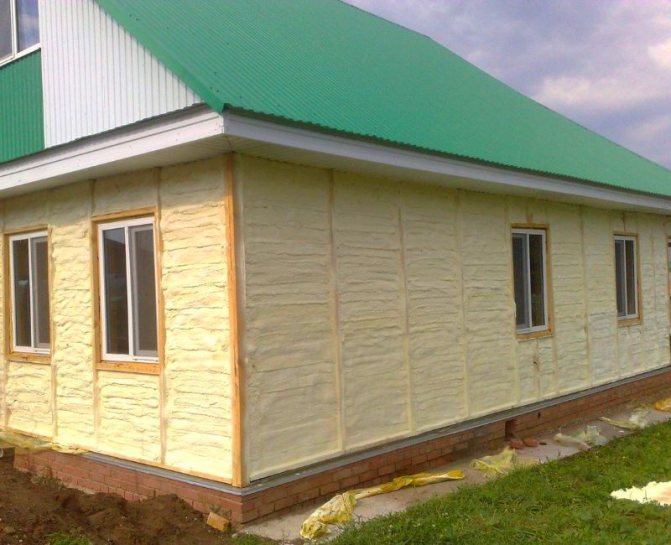

Figure 1. Insulation of the facade of the house with polyurethane foam.
Depending on the composition of the thermal insulation material, polyurethane foam structure may be:
- Semi-rigid - has a cellular and open, but rather dense, structure and is used to insulate facades with wooden base, that is, buildings made of timber, logs or plywood.
- Rigid - has a closed structure and is used for permanent structures made of concrete or brick. Due to its high density, water is not absorbed by the material.
Both types provide excellent moisture protection. PPU does not allow the walls to cool down in winter, even in the most severe frosts and heat up in summer, and with a well-thought-out heating and air conditioning system, the house will have an ideal microclimate all year round. In addition, the material also has good sound insulation properties.
Insulation foam rating
There is a wide range of insulation foams from various manufacturers on the market. This makes her choice a little difficult.
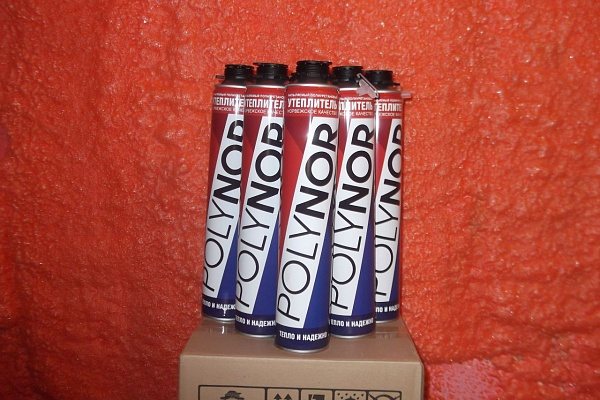

To avoid mistakes using low-quality substances, you should pay attention to products from well-known manufacturers:
- Polynor. Popular sprayed insulation based on polyurethane foam. Very easy to use and has a good vapor permeability... With its help, you can create a high-quality and durable thermal insulation layer. The cost of the cylinder is within 450 rubles.
- Sipur. The material is lightweight, which allows it to be used for facade insulation. It easily tolerates extreme temperatures. The cost of one cylinder is about 430 rubles.
- Teplis - polyurethane insulation, which is widely used for thermal insulation of apartments, industrial buildings, balconies, loggias and other structures. Made on the basis of polymeric materials. Possesses high heat and sound insulation properties. The cost of one bottle (1000 ml) is approximately 650 rubles.
- Ecotermix. Modern popular sprayed insulation. It is widely used for thermal insulation of various structures. To facilitate the application process, it began to be made in the form of balloons. Depending on the thickness of the layer, the cost of insulating 1 m2 will be from 470 to 1300 rubles.
- Heatlok Soy. Two-component sprayed insulation with different densities. It is made from soy extract, vegetable oil, as well as plastic waste. The material is securely attached to any structure, which improves its bearing capacity. Thermal conductivity of polyurethane foam is at a high level. The cost of insulation using such a substance will be about 400-1100 rubles. for 1 m2.
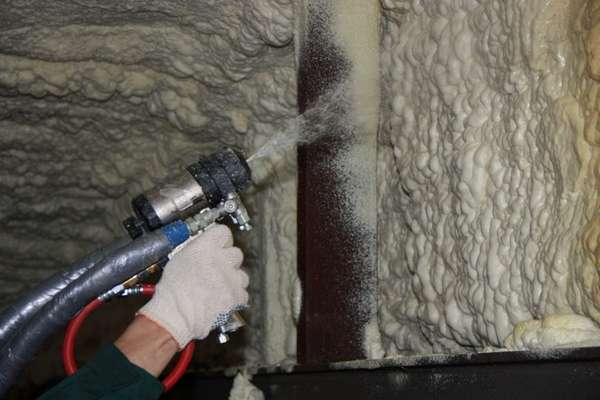

Important! When choosing a material, it is worth considering the peculiarities of thermal insulation work. Particular attention is paid to the thickness of the applied layer and the area of the structure to be treated. With this information, you can more accurately calculate the cost of thermal insulation.
Features of work on the insulation of facades with polyurethane foam
Insulation of the facade with polyurethane foam is carried out by spraying. Liquid PPU It is poured into the tank and, using a pneumatic spray gun connected to the compressor, the mixture is applied to the facade under pressure. As it cools, it turns into foam, which fills in all the cracks on the facade and then hardens. To ensure good adhesion, the walls must be cleaned of dirt and dust before application. Since the foam does not form a uniform surface, after the end of the polymerization process, the master carefully cuts off the excess so that you can make the plaster facing.
Material analysis in comparison with analogues
Modern technologies offer many options for facade insulation.Compared to other thermal insulation materials, liquid thermal insulation PPU has a very high level of thermal conductivity. For example, a layer of 1 cm of polyurethane foam has the same thermal conductivity as 5 cm of mineral wool or 30 cm of reinforced concrete.
Facade insulation technology with polyurethane foam
Application technology liquid heaters requires special knowledge, skills and equipment, so it is difficult to do it yourself. To carry out the work, it is best to hire a team of experienced craftsmen who will quickly take the necessary steps and will be able to provide guarantees for the quality of thermal insulation.
High quality facade insulation at home polyurethane possible only for low-rise buildings. The purpose, size, configuration and geometry of buildings are not important. The whole procedure goes through several stages:
- preparation of walls;
- application;
- reinforcement;
- finishing activities and finishing works.
Selection of equipment for spraying polyurethane foam
The equipment consists of:
- Two cylinders designed for formulationsforming foam.
- Hoses connecting cylinders to spray guns.

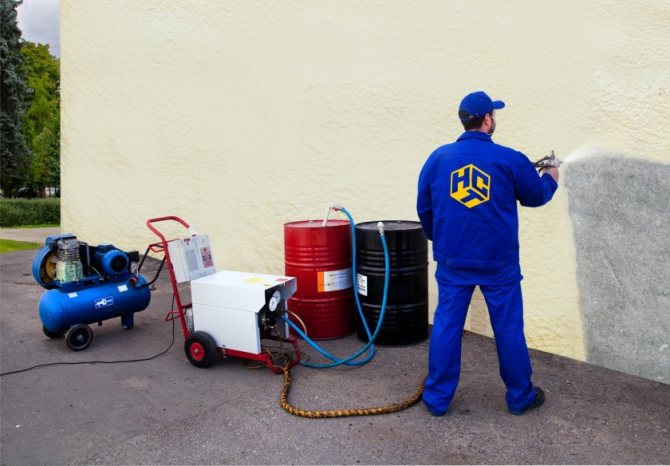
Figure 3. Equipment for spraying polyurethane foam. - Spray gun.
- A set of nozzles of various modifications.
- A set of keys and technical grease.
Set spraying equipment quite voluminous and expensive, so it is impractical to buy it for self-insulation of your own walls. It would be much cheaper and wiser to hire a team of equipped craftsmen.
Instructions for spraying polyurethane foam on the facade
The equipment can be household (disposable) or professional. The assembly of the entire structure is quite simple - hoses with a gun are connected to the cylinders - and you can start spraying.
The optimum temperature of the components for application is 20-30 degrees Celsius. Area theat-insulating material for thermal insulation of facades by spraying depends on the volume of the cylinders. If during the execution of liquid thermal insulation it is necessary to pause, it should be borne in mind that the duration of the operating life of the equipment does not exceed 30 days, so do not pull too long. That is why experts do not recommend purchasing cylinders with a volume open PPU more than necessary.
Preparation for the application of polyurethane foam
Characteristics and properties of polyurethane foam to work require protective clothing. It is important not to leave exposed areas of skin or hair, as after contact with the skin, the foam is extremely difficult to remove. To prevent small particles of foam from getting into the lungs, all work is carried out in a respirator or mask.
Walls must be cleaned of loose particles and old coatings. Lighting fixtures, ebbs, grates and other elements are removed. The crate is installed with cells 20-50 cm. Installation is carried out using a level, which helps to level the walls. Next, a layer is applied polyurethane.
Facade reinforcement rules
To avoid the formation of cracks in the openings, and the finishing materials lay well, it is recommended to reinforce walls special mesh. The procedure begins with the installation of perforated aluminum corners, to which the mesh will be fixed. The corners are installed with assembly glue and gently pressed down with a spatula. Excess glue is removed.
The reinforcing mesh is made of fiberglass and is resistant to chemical and mechanical influences. It is fixed with an adhesive solution, which is sold ready-made in hardware stores.
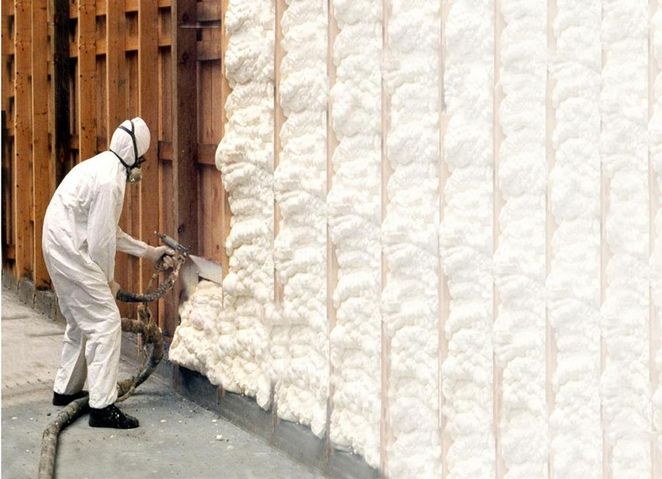

Figure 4. Thermal insulation of facades by spraying.
To achieve good quality, polyurethane foam processed with coarse sandpaper. After removing the dust, glue is applied to the surface, into which the mesh is carefully recessed. The adhesive is evenly distributed over the surface. The mesh does not need to be pulled tightly or pressed into the heat-insulating layer.When the entire facade has been reinforced, it is recommended to apply a second layer glue with a mesh that should not show through.
Finishing works
It takes a day to dry the reinforcing layer and after that you can start finishing work. In order not to violate the integrity of the thermal insulation layer, it is not recommended to use siding or other materials that are mounted on dowels or self-tapping screws.
The best option is a simple decorative plaster for facades. This will allow you to create any effect you like and paint the house in your favorite color.
If you are looking for the most effective method of organizing ideal thermal insulation at home, PPU is the best choice. Since the procedure requires compliance with certain rules, you should carefully, realistically and adequately assess your strengths, and it is best to invite a team of experienced craftsmen.
Features of insulation
For self-insulation of a house with foam, a protective suit is required. Foam is usually sprayed from a cylinder onto the entire surface of the facade, it is used to fill the voids between the walls, rafters, and beams.
The advantages of this type of wall insulation with foam in the air gap are quite many. The main ones include:
- vapor permeability;
- fire resistance;
- the ability to increase in volume;
- resistance to all kinds of mechanical stress;
- the upper temperature limit remains within +80 degrees.
Often, foam is used to seal the gaps that remain after the installation of plastic windows. Due to this, thermal insulation in the apartment also increases. A pneumatic gun is convenient to use for insulating not only windows and outer walls, but also the foundation, loggia and balcony, pipes.
The facade after processing with foam insulation for the walls turns out to be ideal - without visible joints and seams. One container contains an average of 600-700 ml of the composition, which is enough to process a square meter with a layer up to eight centimeters thick. It is very simple to work with such a gun: first, a full cylinder is inserted into it, then you need to direct it to the surface to be treated and pull the trigger. On average, the applied composition hardens within a day.
How to make foam with your own hands
It is worth noting that it is almost impossible to make a sprayed insulation at home. This is due to the fact that the components that make up the substance are quite expensive. Therefore, experts recommend using ready-made formulations.
When the protective equipment is prepared, you can proceed with the direct thermal insulation. Foam insulation is carried out in the following sequence:
- Install the crate on the wall. The dimensions of the slats must correspond to the thickness of the insulation layer. At the final stage, the finishing will be mounted to the crate.
- Remove dirt and dust from the surface. Treat with a primer solution to improve adhesion.

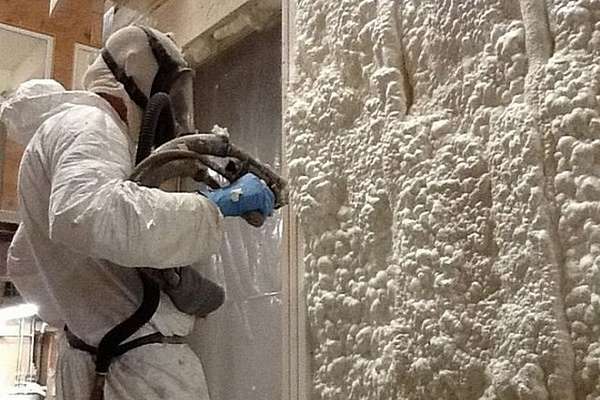
- A uniform layer of insulation is applied to the prepared surface. All gaps and joints are carefully filled. If carried out wall insulation with foam in the air gapthen you need to be careful. When expanded, it can damage the integrity of the structure. If it is not possible to remove one coating, then holes are made in the wall through which the material is fed.
- After the substance has completely hardened, the finishing is done. If a foam insulation was carried out from the outside and the sun's rays fall on the surface of the heat-insulating layer, then there is no need to delay with this. It is best to finish finishing in three days, since it is after this time that the substance completely solidifies.
Immediately before spraying, it is necessary to apply a small amount of the substance to the structure and see how it expands. This will determine how much material to use.
Types of foam insulation
Foam insulation can differ in its structure and composition. The main types of material for insulating walls and windows can be distinguished:
- Penoizol. It contains aldehydes that are harmful to health, although manufacturers often claim the opposite. It dries much longer than polyurethane (complete drying time can be up to three days). It is usually used to insulate attics, load-bearing walls and structures. It can be purchased in the form of ready-made slabs or as a liquid composition.
- Ecowool and foam concrete. Can be purchased in liquid form, more often used for pouring the foundation. When finishing facades, they are practically not used due to the significant weight, which gives a large load on the walls. In addition, the high cost often speaks against this material.
- Polyurethane foam. Suitable only for sealing seams, joints, holes, since it does not allow moisture and steam to pass through, and this is a critical moment for insulating material. When interacting with air, its volume increases twenty times, while there is a minimum amount of air bubbles inside. It can be purchased in convenient small-volume cylinders with a significant shelf life.
- Polyurethane foam or polyurethane. The most common option, which is considered the most versatile. Polyurethane insulation is very effective as a thermal insulation for facades. Consists of two components, they must be mixed by a machine method immediately before application. The foam expands from the initial volume thirty to forty times, small balloons are formed inside. Due to this, high-quality insulation of the house is achieved.
Foam insulation - types of materials
There are a lot of foam materials in construction (polyurethane foam, foam insulation, foam concrete, polyurethane foam, ecowool), but we will not consider everything in detail. Let's weigh the suitability in private construction of several of the most popular ones. Let's start with penoizol, which for private construction can be seen more often in the form of already hardened sheets, but for large scales it is kneaded in special machines, from which it is poured into wall cavities or formwork. The full curing time is about 3 days, but this material is harmful, in any case, the average person thinks, seeing aldehydes in its composition, but the manufacturers deny the danger to humans.
Foam concrete and ecowool are expensive and difficult to use, although the pouring methods are almost no different from the others, therefore they are rarely used for the construction of a private house, which cannot be said about polyurethane foam (PPU) and polyurethane foam. Many people identify these materials, but they still have some differences. Polyurethane foam is considered two-component, its parts are mixed during preparation in a spray machine, and polyurethane foam is one-component, and swelling occurs due to the effect of compressed air on it, under the pressure of which it comes out of the cylinder, in which it is sold ready-made.
The polyurethane foam increases its volume more than 40 times, and the polyurethane foam expands not so much, besides there are fewer closed cavities with air in it, and the polyurethane foam almost completely (by 90%) consists of closed pores, which is why it is more heat-intensive and reliable insulator. Polyurethane foam is sold in cylinders, the covering capacity of which is about 1 m2, and if you insulate a house, then you will need a lot of them, it will not be cheap, therefore polyurethane foam is most often used, which is also called assembly foam in wide circles of builders. It is about her that the conversation will go.
Which variety to choose
In many ways, the choice will depend on the specific situation, which area needs to be processed. You can use an example to consider the most common cases when a house needs foam insulation:
- If you need to close cracks or remove any other defects on the surface, then polyurethane will do. But such material should not be exposed to sunlight.
- If you need to fill a large volume, then Penoizol will do. But the usual cylinder will not be enough here, you will need to purchase a special high-pressure apparatus. It is not at all necessary to buy it - you can rent it or borrow it from friends, because often no one will use it.
- If you need to close up small cracks and carry out thermal insulation in small areas of the area, then you can buy a cylinder with ordinary polyurethane foam. It does not support combustion, after solidification it is particularly hard, while it has an ecological composition.
- If defects are found on the outside of the wall, then you need to apply a composition based on polyurethane. It is applied in a direct way using a special balloon or apparatus.
It is worth remembering that the foam insulation creates errors inside the layer that need to be eliminated. This requires a long hose to push the material inward. If you want to fill air spaces inside the insulation, then holes are made in the wall with something sharp.
Polyurethane foam is not suitable for insulating the entire external facade - it does not have the appropriate characteristics necessary for this. Therefore, you should not choose it for these purposes, even despite its more economical cost.
Features and characteristics
Polyurethane foam, also known as polyurethane foam sealant, is a substance widely used in construction to bond separate parts of the structure to be joined together, heat and sound insulation, seal and fill voids that arise during operation. Usually sold in metal cans, in which the foam itself and a mixture of liquefied gases are under pressure - the so-called. a propellant that acts as a buoyant force for the contents of the cartridge. The versatility of this synthetic polymer makes it an irreplaceable assistant in many types of construction work and in almost any repair.
Of course, polyurethane foam sealant has its own characteristics and characteristics, which will be discussed below.
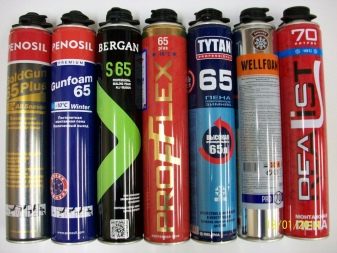

Advantages and disadvantages
Before you start insulating your home, you need to weigh the pros and cons. Of course, many are interested in what the benefits will be from this method of insulation. These include:
- fast speed of insulation, even if a large surface is being processed;
- foam is not subject to biological influences, mold or mildew is unlikely to appear on the wall;
- hardly flammable material: it can melt only at temperatures over 80 degrees;
- it is not required to pre-fix the frame to the facade - this saves energy, time, and money;
- a monolithic surface without seams is obtained, into which cold air could penetrate;
- when insulating pipes or other metal elements, a sufficiently dense layer is created through which moisture does not leak, and corrosion does not appear.
But, like any other method of insulation, it has its drawbacks. You should find out about them in a timely manner:
- should not be exposed to direct rays;
- the impossibility of frequent interaction with water;
- material cost: to insulate large areas, you will need to buy or rent special equipment;
- insufficient level of vapor permeability, you will have to install artificial ventilation inside;
- do not carry out the application procedure without a tarpaulin suit, a respirator mask with goggles and gloves. Of course, all this is unlikely to be found at home, and this is also an extra cash expenditure.
People have long begun to insulate their homes with foam, but the ideal means of insulation has not yet been invented. Of course, the effectiveness of this method cannot be disputed. The main thing is to buy high quality materials. If equipment is available for installation, the process does not take much physical effort and time.
After applying the foam and after it dries completely masters advise treating the surface of the facade with a special coating, which can be purchased at any hardware store. This is required first of all to protect human health, and only then - as protection of the insulation itself.
Advantages and disadvantages of foam insulation
The main advantages of insulation:
- The ability to process even large areas in a short period of time.
- Lack of seams in the coating.
- This material is not subject to decay processes, and mold and mildew do not form on it.
- It is a hardly flammable material that is not subject to combustion, it can only melt.
- By interacting with the metal coating, a dense anti-corrosion protection is created.
- The result is a flat surface that is characterized by excellent heat-saving properties.
- The foam does not deform the substrate to which it is applied.
- Light weight.
As for indicators such as environmental friendliness and durability, I would like to say the following: the material is absolutely safe for long-term use in residential premises.
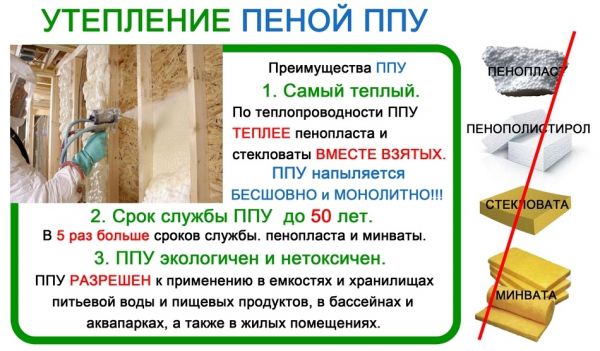

Disadvantages inherent in this type of insulation:
- It is negatively affected by direct sunlight.
- Material can deteriorate from continuous contact with water.
- The tool is not cheap.
- To apply it, you need to create special conditions.
- When working with foam insulation, you need to use a special canvas suit, gloves, a respirator mask and goggles.
- Since this material has a low level of vapor permeability, phenomena inherent in those that occur in a thermos are formed inside the building. Therefore, it is imperative to equip the forced ventilation system of the premises.
Foam cost
If you buy a cylinder at retail, then on average you can pay 300-500 rubles per piece. But this type of insulation is rarely bought separately. Usually its cost is included in the cost of work:
- polyurethane foam - about 100 rubles per running meter;
- penoizol - 700-2000 rubles per cubic meter;
- polyurethane - 3000-5000 per cubic meter.
The price of the material also plays a big role in its choice. But you should not save on high-quality thermal insulation if you need to insulate your home for a long time for a comfortable stay in it.
Foam insulation is suitable for most walls, including panel, block and aerated concrete. Therefore, they can be safely used as insulation for apartments and private houses. Which type of foam to choose is a purely personal matter for everyone. But first, it still does not hurt to learn more about the selected composition, read reviews, get advice from a seller in a hardware store. It is not recommended to use backfill insulation, which easily ignites, in contrast to the foam refractory version. And it is not the most convenient to use, the only exception is the floor surface.
Thermal insulation with liquid foam - better solution, because this procedure, if desired, can be carried out independently, without resorting to the help of specialists. If you do everything right and be careful, you can quickly insulate any surface that needs it.

